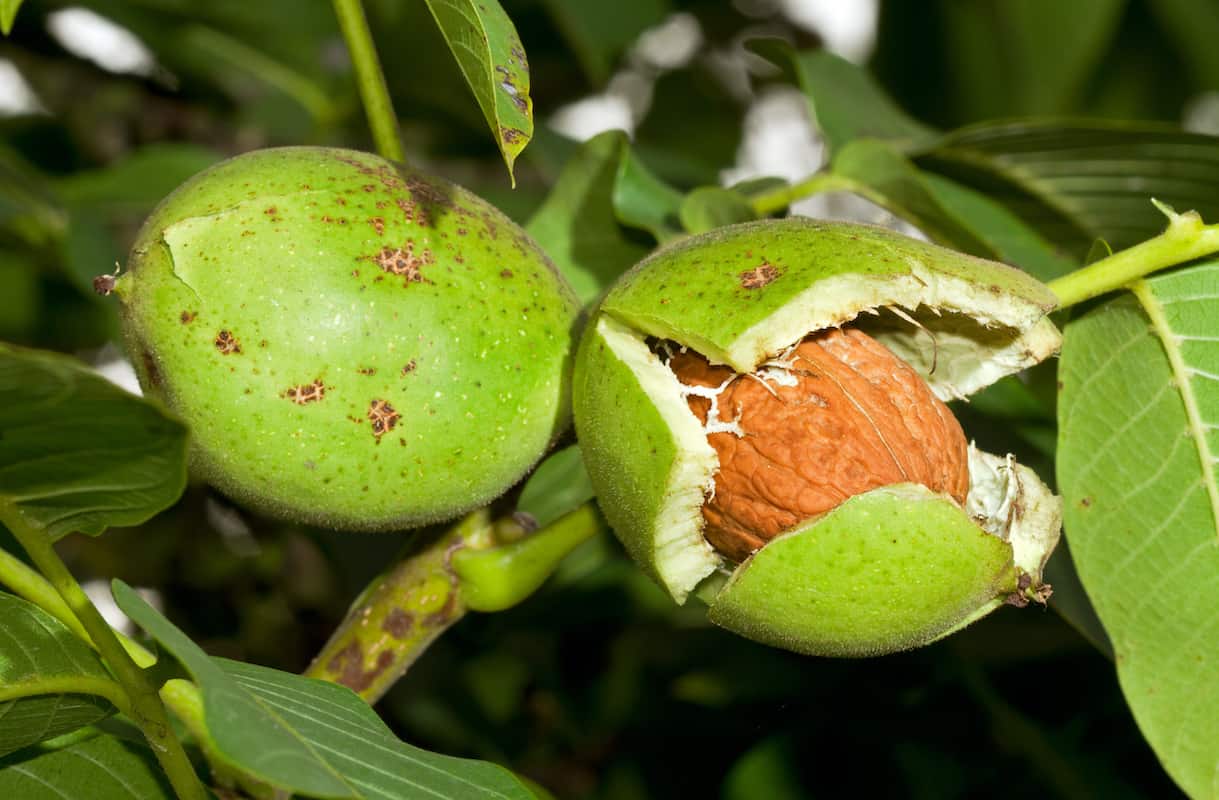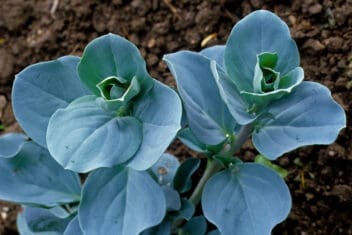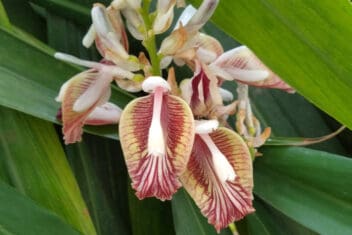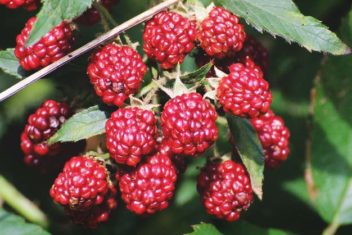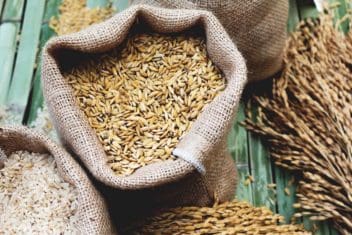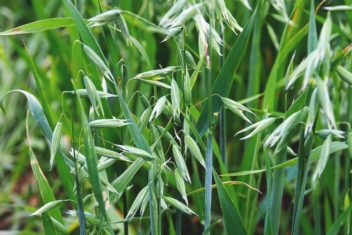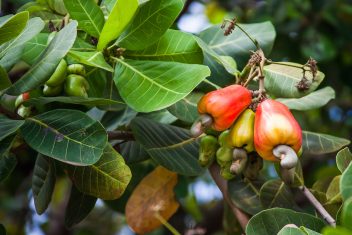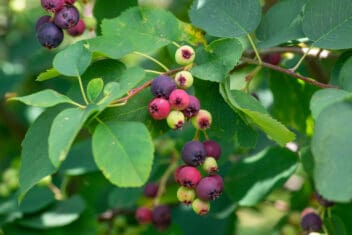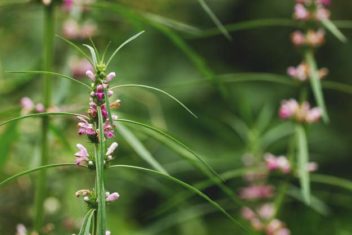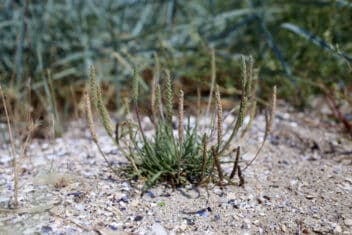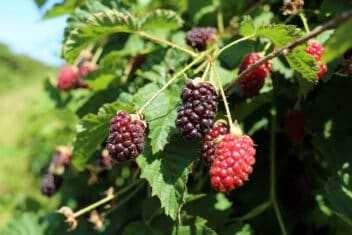I can’t say enough good things about growing walnut trees. As a hardwood, they provide great value to your property. They cool you in summer as a dignified shade tree and warm you up in the winter as firewood. And then there are the delicious nuts, of course!
Walnuts are a long-living tree that will not only be providing you with tons of nutritious food, but it may stick around to feed your kids and their kids as well.
The walnut fruits are wonderful in baking and can be paired perfectly with chocolate in brownies. You have to love that!
Walnut Varieties
You may think there is only one kind of walnut, but nope. There are actually several varieties of walnuts, each producing a slightly different nut.
Black Walnuts (Juglans nigra)
I have a lot of black walnuts that grow wild on my farm, but if you aren’t so lucky, you can purchase young trees to plant. They are native to the Eastern U.S. and grow as far north as Maine in USDA Zones 4-9.

The trees get about 80 feet tall, but they’ve been known to reach as high as 150 feet.
They’re extremely hardy and produce nuts with a semi-sweet flavor. They are delicious baked into a pie. My mother used to say they’re the poor man’s version of pecan pie, but once you try it, you might never go back to pecan.
There are some studies showing that the roots have anti-fungal properties. The nuts on the black walnuts are hard to crack. Many people invest in a professional nutcracker to make their lives easier.
In my area, you can harvest black walnuts and sell them. Buyers come to local feed stores and set up with a scale and pay per pound.
Its a laborious side job but the money does add up. My oldest son and I picked black walnuts one year and made $400. He purchased a LaMancha goat and they were reserve champion at the state fair!
English Walnut (Juglans regia)
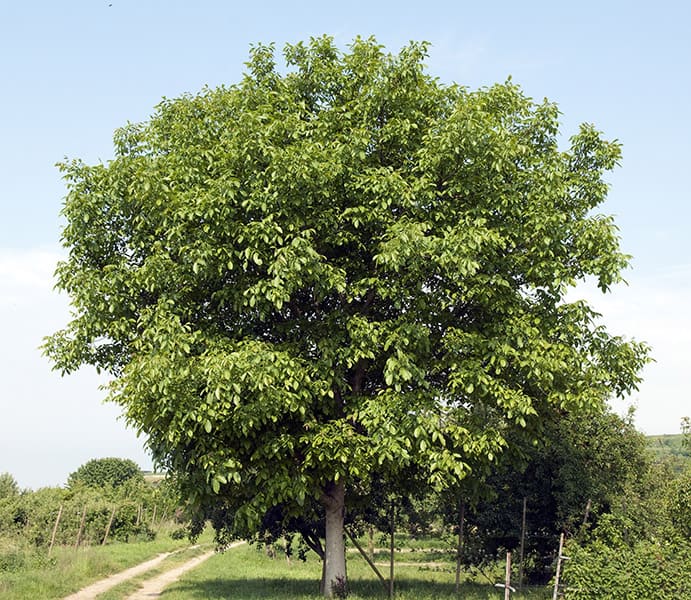
Also known as the Persian or Carpathian walnut since it originated in the Carpathian and Himalayan mountain ranges. Not quite as tall as black walnuts, the English walnut gets to be around 40 feet tall and 40 feet wide.
Grows well in zones 4-9. This type does better in the heat than the black walnut.
Franquette (Juglans regia v. ‘Franquette‘)
This variety is a type of English walnut that is popular on the West Coast and is good in areas with late spring frosts. It produces its flowers late in the year, which means it may not cross-pollinate well with varieties that flower early.
While yields may be lower, Franquette has some resistance to walnut blight. The nuts are large, tasty, and attractive. It has a reputation for high-quality timber.
Lake (Juglans regia v. ‘Lake‘)
The ‘Lake’ walnut is an English cultivar. It has delicious nuts that are easy to hull. When they are ripe the husks break open and you can easily extract the nuts.
This heat-tolerant variety will grow well in the deep south through zone 9. It grows to between 30 and 40 feet high with an equal width.
Northern California Black Walnut (Juglans hindsii)
Surprise! This variety is native to northern California. It gets up to 60 feet tall and 40 feet wide. This tree is endangered, partially because it hybridizes with other walnuts.
It has large leaves that get up to a foot long. The nutmeat is smaller than other varieties, and the shell is thicker. It’s used as a rootstock for English walnuts and for its lovely wood. It grows in USDA Zones 7-10.
Southern California Black Walnut (Juglans californica)
Native to California, this plant is also cultivated in Hawaii. It’s becoming rare as a wild plant in California. It’s closely related to the northern California variety, but grows a bit smaller, reaching about 30 feet tall. It can grow as a single stem tree or as a multi-stem shrub.
While native populations used the nuts, it’s primarily grown for its wood these days. It grows in USDA Zones 8-9.
Butternut (Juglans cenerea)
This is another North American native that comes from the eastern part of the U.S. and Canada. It grows in USDA Zones 3-7. It gets about 60 feet tall and is shorter-lived than some other varieties, living up to 75 years.
Also known as long walnuts or white walnuts, the nuts are extremely tasty, with a buttery, nutty flavor.
What Are Walnuts?
Unlike many of the plants we grow for food in the garden, walnuts are large trees. They are deciduous trees, which means they have foliage from roughly April to November. Then, they lose their leaves for the winter.
Walnuts get extremely tall, up to 80 feet in the home garden, depending on the variety. The trunks can be six feet around. Walnuts live up to 200 years, making them quite a good investment for generations to come.
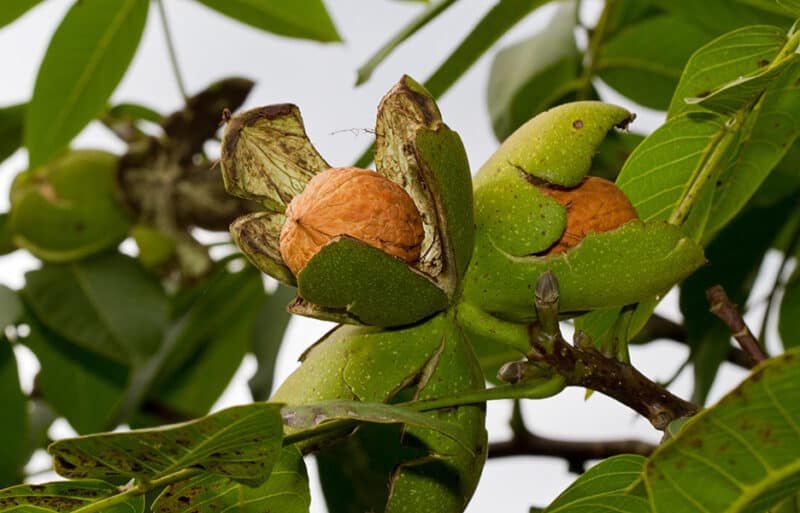
The leaves of walnut trees have a lemon/lime scent. The nut is encased in a fleshy green drupe, or a hull, which protects the nuts as they develop.
Planting Walnut Trees
Walnuts are long-lived trees that like to be in sunny areas but with some shelter. They won’t do well if you plant one or two in the middle of a field. In the wild, they often grow along the edges of forested areas.
Avoid low areas that form frost pockets as young trees are susceptible to frost. In northern parts of their growing area, make sure to get varieties that are late flowering so that flowers don’t get killed by late frosts.
Walnuts tolerate a wide range of conditions however they prefer well-drained, deep, fertile loam with a pH between 6 and 7.
My soil is heavy clay and I have wild black walnuts both along my creek bed and on the slope near my cabin.
Mature walnuts are high yielding. A 15-year-old tree can produce 100 pounds of nuts each year. That will keep you in brownies!
Pollination
Walnuts are monoecious, which means they produce both male and female flowers on the same tree (like squashes). In spring the tree produces slender catkins that hang from the tips of the branches. These are the male flowers. The female flowers are smaller and are located on the tips of the branches.
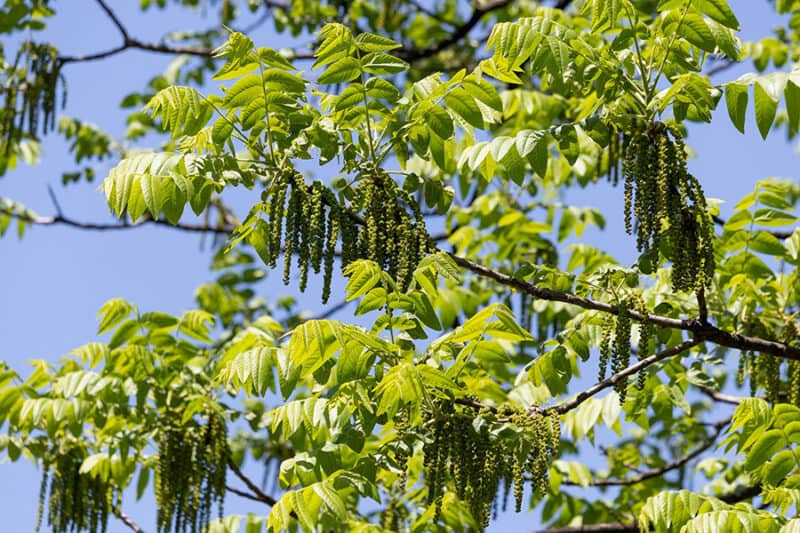
Pollination occurs when the male flower sheds pollen. This pollen is carried by air movement to the female flowers. The pollen can be carried quite far, up to a mile from the producing tree.
Being monoecious, walnuts are considered self-pollinating. However, they bear much better when there are other walnuts around for them to cross-pollinate with.
Sometimes the male and female flowers aren’t active at the same time. This can cause a problem if there is only one walnut in a given area. Multiple walnuts should be planted to ensure good pollination and nut set.
Starting From Seed
Walnuts grow in the wild and you can gather seeds, remove the husks, and plant them. However, the may or may not have the characteristics of the parent trees. Walnuts planted from seed take between 8-12 years before they begin to produce nuts.
The seeds need cold stratification to grow, in most cases, so it’s easier to put the seeds in the ground in the fall. Put them 2-inches deep.
Take the nuts and soak them in water. Any nut that floats should be tossed (or eaten). Only nuts that sink will grow.
Planting Cultivars
Purchase walnut trees from a reliable tree nursery. Dig a hole twice as wide and deep as the container it comes in. Work in some well-rotted manure and put the plant in the hole.
Grafted walnuts will start producing in three to five years.
Caring for Walnuts
Walnuts aren’t fussy trees. Once you get them in the ground, they don’t need too much work.
Fertilizers
When planting out your young trees don’t add too much fertilizer to the hole. It’s better to top dress with some aged compost in the first couple of years. Studies have shown that too much nitrogen makes the walnut susceptible to walnut blight.
Watering
The first couple of years make sure your walnut trees get at least two inches of water per week. Water via drip irrigation or pour water around the drip zone. Be careful not to get water on the leaves as this can spread disease.
Mulch
Walnuts don’t like weeds and competition will slow their growth. Use straw or cardboard to smother weeds and grasses around the drip zone. Make sure to keep mulch away from the trunk of the tree.
Pruning
Train your young walnuts to a central leader. You prune walnuts in the fall to prevent sap bleeding. Keep the tops thin so that light and air can enter.
Companions For Walnuts
Despite the inhibitor issue (see below) the walnut has many plant friends including hickory, which also produces juglone. Other forest trees such as elm, beech, cedar, sweetgum, and birch do well in a mixed forest setting.
If you are using your walnuts as part of an edible landscape there are many shade perennials that will grow around them including holly, witch hazel, spicebush, and astilbe.
Vegetables that can be grown around walnuts include asparagus, beets, and parsnips.
Problems and Solutions to Growing Walnuts
There are only a few problems that you need to look for when growing walnuts.
Juglone Inhibitor
One of the problems with growing walnut trees isn’t an issue with the trees themselves, but how they impact other plants. Walnuts produce an inhibitor called juglone.
Juglone can have a detrimental effect on other plants by inhibiting their respiration. This effects their ability to take in water and other nutrients.
This is something to keep in mind when planting your walnut trees.
Walnut Blight (Xanthomonas campestris)
Blight is the most common nut and foliage disease that affects walnuts. Make sure your trees are in an area with good air circulation. Neem oil can be used to help manage the disease.
Crown and Root Rot (Phytophthora spp.)
Crown and root rot can cause walnut trees to become stunted. If they’re badly infected, they can collapse and die.
Good drainage is key to keeping this disease away. If the soil stays saturated for 24 hours or more, this disease can get a toe-hold. It can help to plant on a berm to improve drainage. You can also purchase resistant rootstock.
Water at the roots only and consider using splash guards on trees to prevent splashback if you use sprinkler irrigation.
Crown Gall (Agrobacterium tumefaciens)
Crown gall, as the name implies, causes tumor-like galls on the trunk, crown, and roots of the plant. The galls are soft, often with a decayed center. It can cause trees to become stunted.
The disease is most devastating on young trees, but once they get a decade old, the trees can withstand the disease a little better.
Purchase certified clean rootstock and don’t let trees get too dry when they’re young. Use caution when working on trees to not damage them and give the disease a place to get in.
Remove any galls you see, but if young trees get too sick, it may be better to just remove them and start over.
Harvesting and Using Walnuts
The nuts in their hulls will drop to the ground when they’re ripe. They should be gathered immediately and hulled. Allow the nuts to dry and then place them in cool storage.
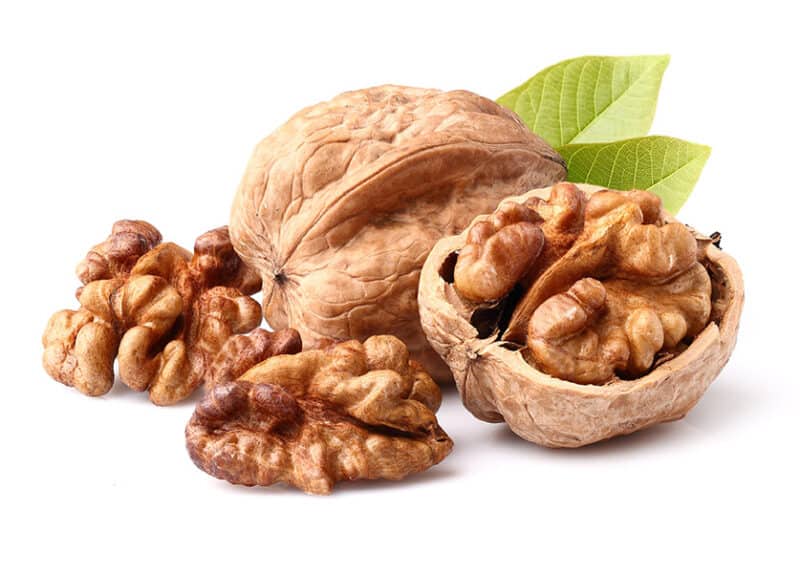
When I say walnut tree you probably think of nuts. However other parts of the tree can be harvested as well.
The leaves of the walnut can be made into wine. You can tap a walnut tree for its sap and make a maple sugar-type syrup.
After you shell your walnuts store them in a cool location. A root cellar or refrigerator is good. Ideally between 32-38°F, with a 55-65% relative humidity.
Nuts, in general, are a healthy food and walnuts are no exception. Doctors often encourage patients to eat walnuts as a heart-healthy snack. Walnuts are high in Omega 3 fatty acids.
Walnuts are also rich in many vitamins and minerals including good amounts of thiamin, vitamin B6, vitamin E, iron, zinc, and potassium. They’re high in fiber and protein.
The leaves have a medicinal value as well. The bark and leaves are often used in the treatment of skin problems and have been used to treat herpes sores and eczema.
Mix together one ounce of dried leaves with a pint of boiling water. Turn off the heat and let sit for six hours. Apply as a poultice. You can also drink this to help with ulcers.
Give These Beautiful Trees a Place in Your Garden
Because they are trees, walnuts, do require more planning. They take longer to grow and will take up a significant anmount of space. However, if you have the time and the room, walnuts are a valuable crop for both the home and commercial gardener.
